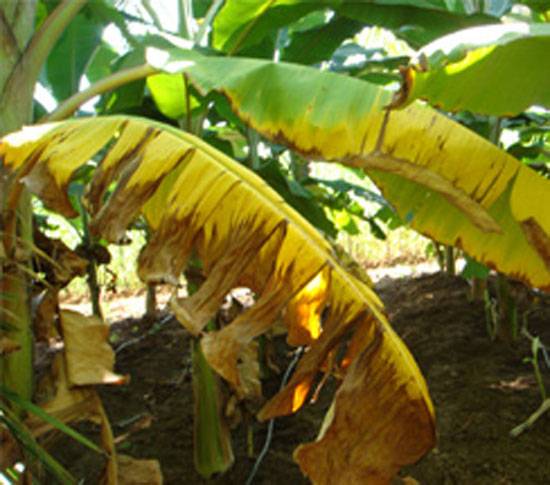Banana-TC
Banana stem weevil

Banana stem weevil
Odoiporus longicollis

Banana stem weevil
Odoiporus longicollis

Banana stem weevil
Odoiporus longicollis
Banana Pseudostem Borer (Odoiporus longicollis)
The banana pseudostem borer, Odoiporus longicollis, is a major pest of banana and plantain plants. It attacks the leaves and stems of the plant, causing heavy losses to farmers.
Symptoms
- Small pinhead-sized holes on the stem
- Fibrous extrusions from the bases of leaf petioles
- Rotting and foul odor
- Dehydrated condition with premature ripening of the bunch
- Yellowing of leaves
- Grubs bore into the pseudostem, making tunnels
- Cutting holes on the outer surface
- Exudation of plant sap, followed by a blackened mass from the borehole
- Tunneled parts decompose, causing the pseudostem to wilt
- Leaves turn yellow, and the plant becomes susceptible to wind damage
- If the larval tunnel passes through the central growing point, the plant is killed
Life Cycle
- Eggs: Yellowish-white, cylindrical, and have rounded ends; laid at random on cut ends of the pseudostem
- Larvae (Grub): Stout, soft, whitish to cream-colored, legless; apodous with a dark brown head
- Pupa: Pale yellow color, fibrous cocoon formed inside the tunneling on the periphery
- Adult: Robust, reddish-brown and black weevil; strong fliers and can live for a year
Pest Management
Chemical Control
- Chemical insecticides can be used to manage the pest effectively.
Biological Control
- Naturally infecting biological control agents, such as entomopathogenic fungi, can be used instead of harmful chemicals.
Other Information
- The adult weevils are black-colored and measure 23-39 mm.
- Red-colored morphs of the banana pseudostem borer are also encountered in certain banana-growing areas of India.
- The weevils are predominantly nocturnal in habit.
- The infestation starts with 5-month-old plants.
- The larva's characteristic habit of cutting a rectangular hole just before completing the cocoon helps locate the cocoon inside the pseudostem.
- In Manipur, India, research found that O. longicollis larval damage to the pseudostems caused plants to fall before the fruit matured.
Life cycle
Egg: The incubation period is 3–5 days.
Grub: The larval duration is 21–23 days, with a pre-pupal period of 2–3 days.
Pupa: The pupal stage lasts 8–10 days.
Adult: The adult lives for about 65–200 days under laboratory conditions.
Grub: The larval duration is 21–23 days, with a pre-pupal period of 2–3 days.
Pupa: The pupal stage lasts 8–10 days.
Adult: The adult lives for about 65–200 days under laboratory conditions.
Conclusion
The banana pseudostem borer is a serious pest that can severely impact banana cultivation. Early detection, proper management strategies, and integrated pest control methods can help mitigate the damage and reduce crop losses
Blog
Explore Our Blog

